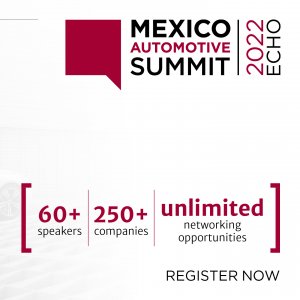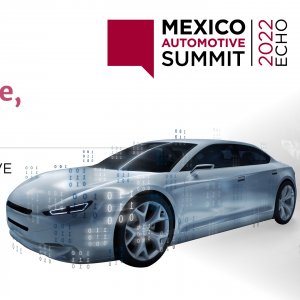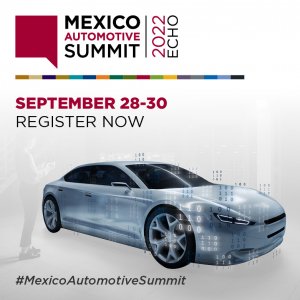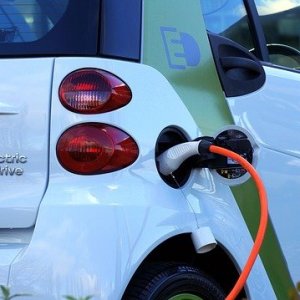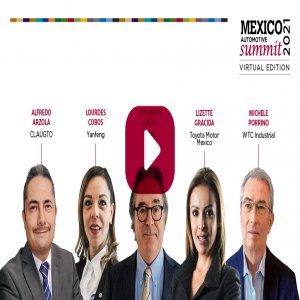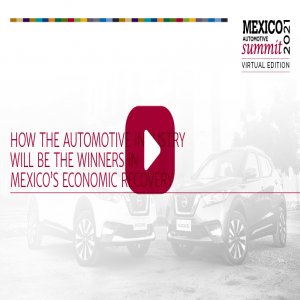
5G: Pillar for Autonomous Solutions
 By Jorge Ramos Zwanziger | Junior Journalist and Industry Analyst -
Thu, 03/25/2021 - 14:52
By Jorge Ramos Zwanziger | Junior Journalist and Industry Analyst -
Thu, 03/25/2021 - 14:52
You can watch the video of this panel here.
Synergies between tech companies, chip manufacturers and technology innovators can forever change the way we understand vehicles, how they move and how they react, taking connectivity to a whole new plain. Luz Elena Jurado, CEO of Volvo Trucks, and Ricardo Anaya, Staff Product Manager of Qualcomm Mexico, addressed developments in connectivity during the panel, “Connectivity, 5G and Autonomous Vehicles,” moderated by Alejandro Enríquez, Senior Industry Analyst and Journalist at Mexico Business News.
“5G is the next generation of telecommunications. It has three main characteristics: an enhanced mobile broadband, critical mission services and massive IoT capabilities,” stated Anaya during Mexico Automotive Summit on Thursday, Mar. 25. He highlighted the benefits of 5G, through which users can experience an incredibly fast download speed of 20 gigabits and an upload speed of 20 gigabits, as well. When it comes to a vehicle, it is all a matter of speed. “Data in a vehicle is very relevant. Systems require latencies of less than 3ms for a vehicle’s sensors to detect if the shape that they detect around them is a tree, a pole or a person,” Anaya detailed. The next generation of vehicles needs fast connectivity to deliver even better solutions, something the automotive industry has to take advantage of.
Connectivity, a very popular word throughout the pandemic, was the focal point of Jurado’s remarks, who said the visionary efforts Volvo Group made for the development of autonomous solutions, which already exist in Europe and North America. “Volvo Group has over 1 million machines connected all over the world.” She mentioned two technological solutions the company has started implementing: Remote Programming and Remote Diagnostics. The latter allows clients and distributors to optimize many processes regarding the state of the vehicle and how it can be fixed. “Connectivity reduces operating costs through the optimization of processes and diagnoses that can prevent future problems,” Jurado added. Connectivity, in this sense, allows faster information sharing, so repairmen know what is wrong with the vehicle before it reaches the shop. “Clients and fleet managers may arrive to an appointment and have all their car parts ready to fix a truck in less than 2hrs.”
Volvo also promotes the use of remote programming, so a driver can update a vehicle’s software based on the task at hand. “This allows us to prevent any accidents, reducing traffic which is something positive for everyone,” said Jurado. Autonomous solutions are a priority for Volvo Group and the goal is for these alternatives to be less polluting, according to Jurado. She gives the example of Vera, an already operational self-driving truck that is 100 percent autonomous and electric. The truck is completely driverless and it can connect to other trucks nearby. It can provide information on its battery charge and also how long it will take it to get to its final destination. “It is no longer necessary to have a driver for short distances,” said Jurado.
“We are living through a transformation that is necessary to keep moving and keep business and industries alive. In the past 10 years, vehicles have changed more than they did in the previous 100 years,” said Anaya. He also introduced the concept of Cellular Vehicle to Everything (C-V2X), which is a protocol created for vehicles to communicate with each other but also with cyclists, people and road infrastructure. “Connectivity is essential for vehicles to be able to make decisions,” said Anaya. This type of technology allows for a vehicle to know what is happening around it, if there is a truck nearby, if there was some sort of error or if a bridge did not lower and it cannot cross. “This is the importance of connectivity; this is the future of the vehicle, the future of smart cities and even of ports and factories,” he added.
Connectivity Infrastructure
Vehicle connectivity demands 5G, said Jurado. “It has a broader bandwidth, it gives data at a faster rate. It allows more data to be available for processing.” It is essential for the entire ecosystem then, to be able to work with 5G technology. However, Jurado mentions some obstacles. “There are great challenges: integration, synergy and association with the government are vital to have access to this 5G connection,” she said.
Jurado gives the example of a streetlight, which is owned by the state, unlike other vehicles that might belong to a person or a company and that can be more prepared in terms of communication technology. “There is a huge synergy challenge between the private initiative and the government,” she said. Both Anaya and Jurado agreed on how important this synergy is for the establishment of the necessary regulation. “We need to think about the rules at play, which are extremely important for the regulation of vehicle autonomy,” argued Jurado.
Jurado spoke with a sense of urgency when talking about how Mexico needs to adapt in terms of technology. “If we do not work on this, 2030 will catch up to us.” She talked about how there are already many electric trucks being used by big companies like DHL or Estafeta and how Mexico does not have the infrastructure to run them. “In 2030, there will be a world full of autonomous solutions. We need to prepare for this now,” she said.
5G has the capacity to replace all existing networks, according to Anaya. “We need to follow global trends; it is not about reinventing the wheel. It is not a matter of maybe yes or maybe not, but a matter of when,” he added. Making the transition to 5G is not only vital for connectivity. Anaya argues it also vital for safety and the environment, which he believes could even reduce carbon emissions. Jurado urged other truck companies to take advantage of current technologies and even encouraged them to promote them among other manufacturers. In a world that is ever-more connected, the creation of the proper infrastructure is not a recommendation but the path to take, the panelists concluded.
